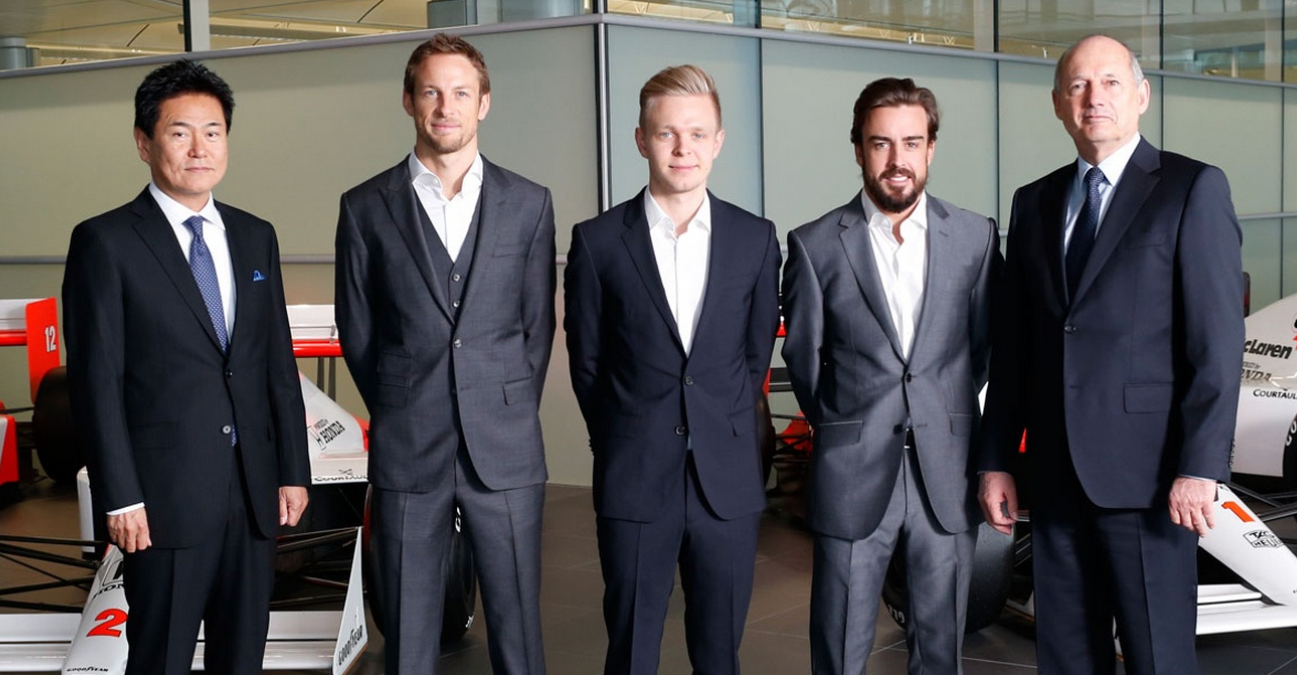
With the season-opening Australian Grand Prix on us, we look at what’s new in Formula 1 in 2015.
Honda’s return
The most exciting change for 2015? A historic partnership – one that won 15 out of 16 races in 1988 and took four drivers’ and constructors’ championships between 1988 and 1992 – has been reborn. Honda has returned to Formula 1 with McLaren to meet the technical challenges of a thrilling new hybrid-powered era.
Minimum weight
Since F1’s minimum-weight rule applies to the combined weight of car and driver, neither has room for excess ballast. The challenge of designing competitively light cars with the new hybrid power units came under the spotlight last year, when several drivers complained that they’d had to lose an unhealthy amount of weight to compensate. For 2014 the minimum total weight of the car and driver has been raised from 691kg to 702kg, so the era of extreme dieting has come to an end.
Nose jobs
Low noses were brought in for safety reasons in 2014, but with this being an aerodynamically sensitive area the result was some quite ugly-looking designs as teams tried to minimise the effect on air flow. For 2015 the wording of the rules has been tightened so that the noses look better.
Power unit numbers
Each driver is allowed just four complete power units for the whole season, down from five in 2014 – and the penalties for going over the limit have changed slightly. While drivers will still be hit with a grid penalty for going beyond the limit, they will no longer be carried over to the next race if the driver cannot take the full penalty (for instance, if given a 10-place penalty when there are fewer than 10 positions behind them on the grid). Instead, they will be given time penalties for the race that increase on a sliding scale.
Power unit development
Thanks to a loophole in the rules, power unit manufacturers can now make changes to their designs during the season. The original intention was for this to be banned, but no cut-off date was written into the rules.
Development is still limited, though: while 92 per cent of the power unit can be changed, this is governed by a system of ‘tokens’. Working like a fantasy league game, this system rates each part of the power unit according to its effect on performance, and each team has an annual ‘budget’ of just 32 tokens it can ‘spend’ on making changes. In practice this works out at 48 per cent of the total that’s open to development.
Double points
Although it ultimately made no difference to the outcome of the championship, a new rule applying double points to the final race of the year proved unpopular with fans and entrants alike in 2014. This rule has now been dropped.
Independent suspension
So-called FRIC (front-rear interconnected) suspension systems, which brought a number of performance advantages, have been banned. The rules now say that a car’s suspension can only respond to direct load on the appropriate end of the car.
Side impact
In recent years the cars have had Zylon anti-intrusion panels bonded in to the cockpit sides to prevent injury in ‘t-bone’ accidents. These have now been extended vertically to the area of the cockpit opening by the driver’s head.
Ratios rationed
Once upon a time, teams could change the ratios in the gearbox at every race (if they had the time). For 2014 just one set of gear ratios had to be chosen for the entire year, with one ‘joker’ change permitted during the season. Now even that allowance has gone, so the gear ratios nominated for Melbourne will have to be competitive at every grand prix of the year.
New faces
Along with double world champion Fernando Alonso returning to McLaren to partner Jenson Button, four-time champion Sebastian Vettel moves to Ferrari and Marcus Ericsson joins Sauber. Daniil Kvyat slots in to Vettel’s former seat at Red Bull, while Formula 1 also welcomes some exciting new talent in the form of Red Bull Juniors Max Verstappen (third in European Formula 3 last year) and Carlos Sainz Jr (Formula Renault 3.5 champion), and Felipe Nasr (third in GP2). Ferrari also have a new team principal, Maurizio Arrivabene, and Lotus have swapped from Renault to Mercedes power.
Virtual safety car
In response to Jules Bianchi’s accident at Suzuka last year, the FIA has introduced a new system to reduce car speeds in danger zones. In situations where double-waved yellow flags are needed in a particular area of the track, but conditions elsewhere do not require the safety car to be deployed, a speed limit will be enforced in the ‘virtual safety car’ (VSC) caution area.
Less testing
The number of in-season test sessions has been reduced from four to two. They will take place on the Tuesdays and Wednesdays following the Spanish and Austrian Grands Prix, and each team must field ‘rookie’ drivers (ones with fewer than two F1 starts) on two of the four days of running.
Restarts still roll
The plan to make the field halt on the grid and run through the start procedure again after safety car periods has been abandoned.
Mexican wave
After an absence of more than two decades, the Mexican Grand Prix returns to the F1 calendar in 2014 at the same venue, the Autodromo Hermanos Rodriguez. Located in downtown Mexico City, the circuit has had to be redeveloped to suit modern safety and infrastructure standards. Unfortunately that also means the loss of its iconic final corner, the Peraltada, where Ayrton Senna flipped his MP4/6 during qualifying for the 1991 Mexican GP. With only a tiny run-off area and then a concrete wall with a busy multi-lane highway on the other side, there was no way of making it safer.